28 October 2024 : Daily Current Affairs
1. Spain PM Pedro Sanchez Visits India to Boost Bilateral Ties, Inaugurate First Private Military Aircraft Plant in Vadodara
- 1. Spain PM Pedro Sanchez Visits India to Boost Bilateral Ties, Inaugurate First Private Military Aircraft Plant in Vadodara
- 2. India’s Crude Oil and Natural Gas Import Dependency Rises Amid Stagnant Domestic Production and Growing Demand
- 3. New rocket, plus moon and Venus missions, herald new beginnings
- 4. Why is Delhi’s air quality deteriorating?
- Prelims Facts
- 1. ‘Run for Unity’, held on ‘Rashtriya Ekta Diwas’, the birth anniversary of Sardar Vallabhbhai Patel, will be organised this time on 29th October
- 2. India’s Nature Conservation Index rank 176, govt. slammed
- 3. Carbon credit: the right to emit
- 4. India Launches 21st Livestock Census: Digitized Effort to Capture Comprehensive Data on Nation’s Livestock and Poultry
- (Source: Indian Express; Section: Explained; Page: 15)
- 5. Researchers Uncover Genetic Mechanisms in New Tardigrade Species That Enable Radiation Resistance, Paving the Way for Medical and Space Exploration Advances
- (Source: Indian Express; Section: Explained; Page: 15)
- 6. Indians Lose Rs 120 Crore in ‘Digital Arrest’ Scams Linked to Southeast Asia, Reveals Government Data
- (Source: Indian Express; Section: Cover Page; Page: 01)
(Source: Indian Express; Section: Cover Page; Page: 01)
| Topic: GS2 – International Relations |
| Context: |
|
Analysis of News:
Inauguration of C295 Assembly Plant
- Sanchez and Modi will inaugurate the Final Assembly Line (FAL) plant for the C295 medium-lift tactical transport aircraft, a collaboration between Tata Advanced System Limited (TASL) and Airbus Defence and Space.
- This Vadodara facility marks India’s first private military transport aircraft production plant, set to replace the IAF’s aging Avro fleet.
- The plant, a significant milestone in the “Make in India” aerospace program, will support aircraft production, assembly, testing, and lifecycle maintenance.
C295’s Role and Capabilities
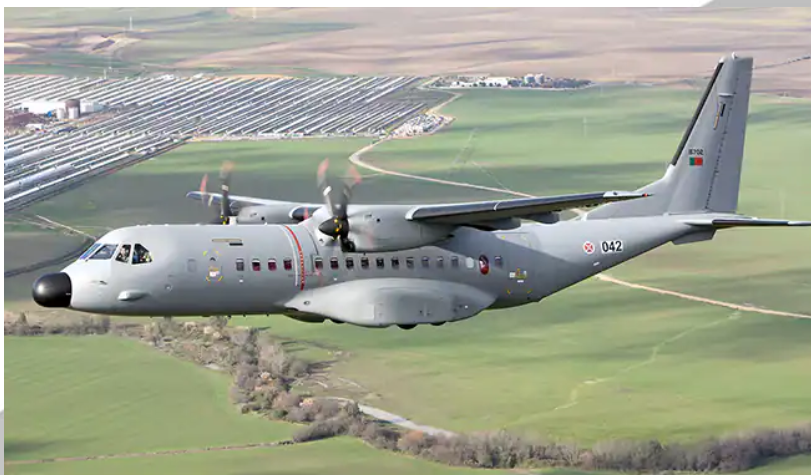
- The C295 aircraft, suitable for both combat and relief missions, can operate from unprepared airstrips and transport up to 71 troops or 50 paratroopers.
- It supports tactical air drops, medevac operations, disaster response, and maritime patrols, adding significant versatility to the Indian Air Force.
- Airbus will deliver the first 16 aircraft from Spain, while TASL will manufacture the remaining 40 in Vadodara, with deliveries expected to continue until 2031.
Economic and Industrial Collaboration
- The $2.5 billion contract between India’s Ministry of Defence and Airbus DS is also India’s first full-fledged private sector aerospace project, engaging defense public sector units like Bharat Electronics Ltd, Bharat Dynamics Ltd, and various MSMEs.
- This venture not only strengthens defense ties but also positions India as a new assembly hub outside Airbus’s Seville facility, which currently assembles the C295 and A400 aircraft.
Strengthening Cultural and Economic Bonds
- Sanchez’s visit also aims to foster cultural and economic cooperation, with engagements in Mumbai’s entertainment sector and a speech at the 4th Spain India Forum.
- India and Spain expect to sign multiple MoUs during this visit, further enhancing partnerships in IT, pharma, infrastructure, and agro-tech, reflecting the fresh momentum in India-Spain relations since Modi’s 2017 visit to Spain.
| What is the Significance of this Manufacturing Facility? |
|
| PYQ: Examine the developments of Airports in India through Joint Ventures under Public-Private Partnership (PPP) model. What are the challenges faced by the authorities in this regard. (150 words/10m) (UPSC CSE (M) GS-3 2017) |
| Practice Question: Discuss the significance of India’s first private military aircraft production plant in Vadodara in bolstering India’s defense capabilities and promoting the ‘Make in India’ initiative. How does this project reflect the growing strategic and economic ties between India and Spain? (250 words/15 m) |
2. India’s Crude Oil and Natural Gas Import Dependency Rises Amid Stagnant Domestic Production and Growing Demand
(Source: Indian Express; Section: Economy; Page: 13)
| Topic: GS3 – Indian Economy |
| Context: |
| India’s increasing reliance on imported crude oil and natural gas highlights the challenges of rising energy demand and limited domestic production. |
Analysis of News:

Rising Import Dependency on Crude Oil and Natural Gas
- India’s import dependency for crude oil and natural gas has increased in the first half of FY25, reaching 88.2% and 51.5%, respectively, as domestic production remains sluggish amidst rising demand.
- This is a continuation of an upward trend, with oil dependency rising from 83.8% in FY19 to the current level, reflecting a widening gap between consumption and domestic output.
Economic Vulnerabilities
- India’s high reliance on imported oil makes its economy vulnerable to global price volatility, impacting the trade deficit, foreign reserves, inflation, and the rupee’s value.
- Despite government efforts to reduce import reliance, such as incentivizing domestic production, the limited growth in oil output hampers progress towards self-sufficiency.
Push for Natural Gas as a Transition Fuel
- The government aims to increase natural gas’s share in India’s energy mix to 15% by 2030, up from around 6% currently.
- Natural gas, being less polluting and typically cheaper than oil, is promoted as a transitional fuel.
- However, higher imports of natural gas, as seen with a 23% year-on-year increase in the first half of FY25, add to the import dependency challenges.
Efforts Towards Reducing Oil Imports
- To mitigate oil imports, the government has implemented policies encouraging electric mobility, biofuels, and alternative fuels.
- Although there has been a rise in electric vehicle adoption and biofuel blending, these measures are insufficient to offset the growing demand for petroleum products, with domestic production only meeting 11.8% of consumption in H1 of FY25.
Persistent Challenges
- India’s oil and gas import bill rose significantly in H1 of FY25, with crude oil imports costing $71.3 billion and natural gas imports at $7.7 billion.
- Despite ambitious targets set in 2015 to reduce oil import reliance to 67% by 2022, dependency has grown, highlighting the pressing need for sustainable solutions to manage the country’s increasing energy demands.
| How can the Dependence on Oil and Gas be Reduced? |
|
Setting Concrete Targets: Developed countries have absolutely no excuse – new oil and gas investments should have ended already. All the countries, especially richer countries, need to lead on this, and set phase-out dates for all fossil fuel production. Embrace Renewable Energy Innovation: Countries shall invest in research and development to accelerate the advancement of renewable energy technologies. This includes funding for breakthrough technologies such as next-generation solar panels, advanced wind turbines, and energy storage solutions. Foster International Collaboration: Countries can collaborate on research, knowledge sharing, and joint initiatives to develop innovative solutions for reducing oil and natural gas consumption. Sharing best practices and lessons learned can accelerate progress globally. Aid for Capacity Building: Developed countries shall assist developing countries in building their capacity to implement sustainable energy projects through technical assistance, training programs, and knowledge sharing. Green Industrialisation: Countries shall promote the development of green industries, such as renewable energy manufacturing, to create local job opportunities, increase energy self-sufficiency, and reduce dependence on fossil fuel imports. |
|
PYQ: The term ‘West Texas Intermediate’, sometimes found in news, refers to a grade of (2020) (a) Crude oil (b) Bullion (c) Rare earth elements (d) Uranium Ans: (a) |
| Practice Question: Examine the economic and strategic implications of India’s growing dependency on imported crude oil and natural gas. Discuss the measures needed to enhance energy security and reduce import reliance in the face of rising domestic demand. (250 words/15 m) |
3. New rocket, plus moon and Venus missions, herald new beginnings
(Source – The Hindu, International Edition – Page No. – 7)
| Topic: GS3 – Science and Technology |
| Context |
|
Here’s a Breakdown of Important ISRO Missions:
Gaganyaan Human Spaceflight Programme
- Goal: India’s first crewed space mission, aimed at demonstrating human spaceflight capabilities.
- Components: Includes two uncrewed missions and one crewed mission to Low Earth Orbit (LEO).
- Status: The Union Cabinet has approved additional funding for an extra uncrewed flight, bringing the total to four missions.
- Budget: Received ₹11,170 crore in additional funding.
- Timeline: Expected uncrewed missions will occur before the final crewed flight, likely launching by 2025.
Bharatiya Antariksh Station 1 (India’s Space Station)
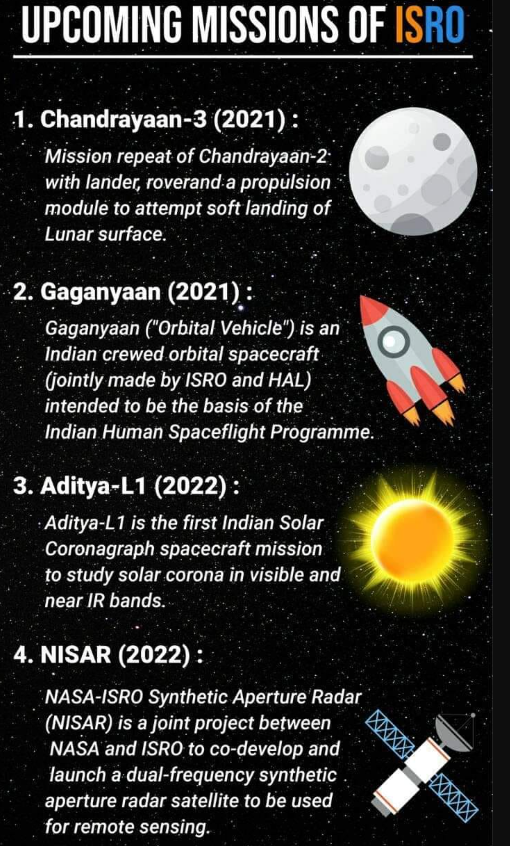
- Objective: India’s first space station, designed to support research in space science and technology.
- Details: Four missions are planned to test technologies critical for the space station’s establishment.
- Budget: The project received a budget allocation of ₹11,170 crore.
- Timeline: Planned completion by 2028, after successful technology validation and testing.
Next Generation Launch Vehicle (NGLV)

- Purpose: A new rocket to replace the PSLV and GSLV series, supporting diverse missions from low earth orbit to interplanetary.
- Funding: Cabinet approved ₹8,240 crore for its development, including the first three test flights.
- Industry Role: ISRO to partner with private industry for streamlined operations.
- Significance: Aims to enable India’s space autonomy by supporting various mission payloads and requirements.
Polar Satellite Launch Vehicle (PSLV) – Private Sector

- Objective: A PSLV constructed by Hindustan Aeronautics Ltd. and Larsen & Toubro.
- Expected Launch: End of 2024 or early 2025.
- Role: First PSLV fully developed by Indian private sector entities, marking a shift towards industry-driven launch capabilities.
- Significance: Enhances ISRO’s launch frequency and reduces dependence on in-house manufacturing.
Chandrayaan-4 Moon Mission
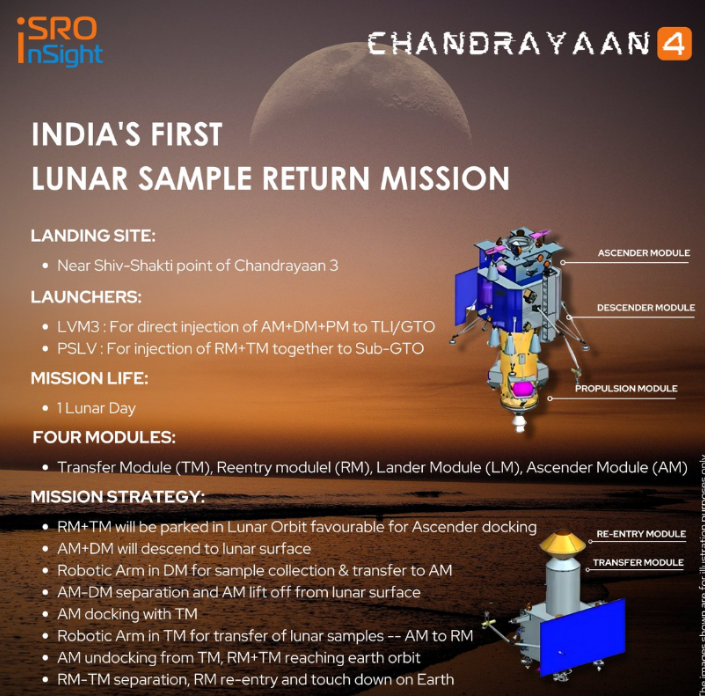
- Mission Type: Sample-return mission targeting lunar surface.
- Launch Vehicle: Components launched separately on LVM-3 rockets, docked in Earth orbit.
- Landing Site: Near Chandrayaan-3’s site to retrieve moon soil and rock samples.
- Budget & Timeline: Estimated cost is ₹2,104 crore; planned launch by 2027.
- Objective: Provides insight into the moon’s surface and subsurface properties through returned samples.
Lunar Polar Exploration Mission (LUPEX) with Japan

- Goal: A joint mission with Japan focusing on exploring lunar poles.
- ISRO Role: Developing a new lander variant that could support crewed missions in the future.
- Objective: Studies the lunar south pole region, analysing resources for potential human exploration.
- Importance: Advances international collaboration and India’s lunar exploration expertise.
Venus Orbiter Mission
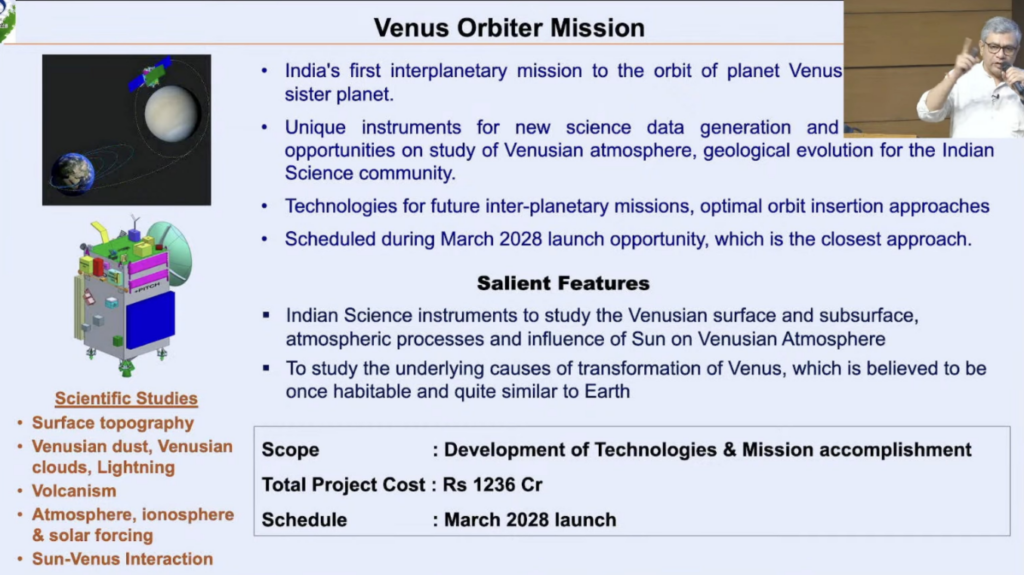
- Objective: Explore Venus’s surface and atmosphere to understand planetary evolution.
- Timeline: Expected to launch in March 2028.
- Budget: Approved at ₹1,236 crore.
- Focus: Investigation into Venus’s greenhouse effect, geological activity, and atmospheric conditions.
Space Based Surveillance (SBS-3)
- Scope: Third phase of space-based surveillance, building on earlier SBS-1 and SBS-2 missions.
- Components: Involves deploying 21 ISRO-built satellites and 31 private sector-built satellites.
- Budget: ₹26,968 crore.
- Purpose: Enhances India’s capability in space-based monitoring, crucial for defence and environmental applications.
NISAR (NASA-ISRO Synthetic Aperture Radar)
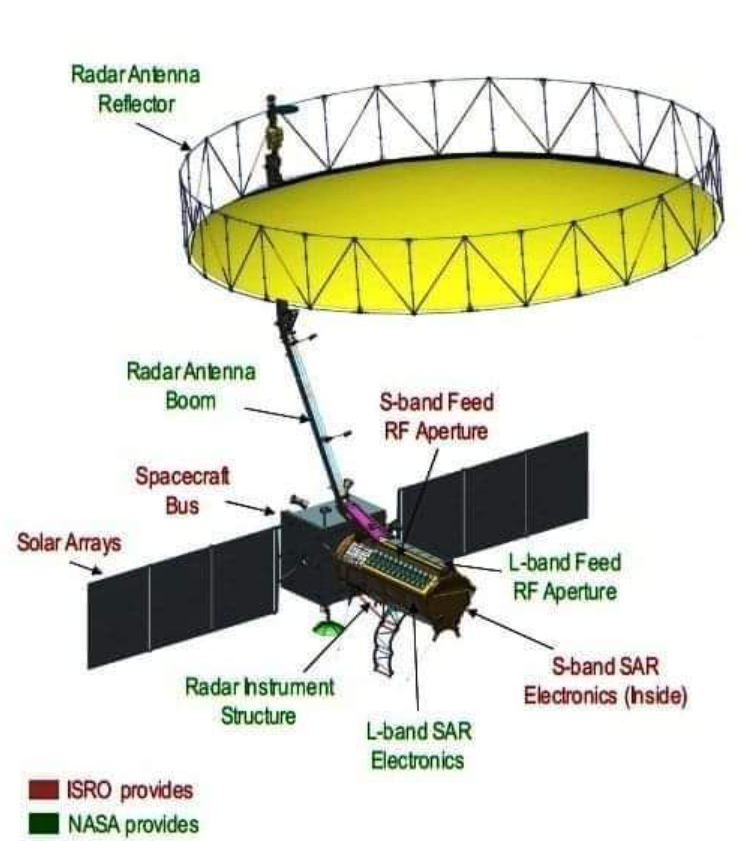
- Purpose: Joint Earth observation mission with NASA to monitor land and ice movements.
- Challenges: Satellite required additional thermal protection after tests revealed high launch temperatures.
- Launch Timeline: Expected in early 2025 via GSLV.
- Significance: One of the most advanced radar satellites, essential for climate and environmental studies.
Proba-3

- Objective: European Space Agency mission to study the Sun’s corona.
- Mechanism: Two satellites work in tandem, with one satellite blocking the Sun to simulate an eclipse.
- Launch Timeline: Planned for November 29 on a PSLV-XL.
- Significance: Enhances understanding of solar corona and solar storms, impacting space weather prediction.
Astrosat
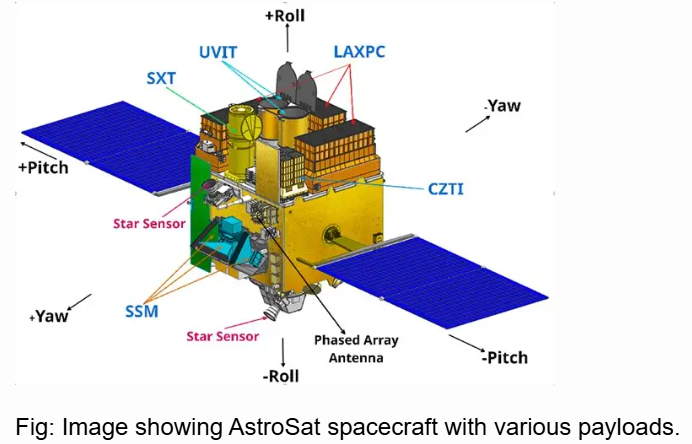
- Description: India’s first multi-wavelength space observatory, launched in 2015.
- Achievements: Provided data for over 400 research papers; outlasted its initial five-year mission life, now in its ninth year.
- Current Status: Expected to operate for another two years based on fuel levels.
- Impact: Contributed significantly to space research in ultraviolet, optical, and X-ray observations.
| PYQ: Q.1 What is India’s plan to have its own space station and how will it benefit our space programme? (150 words/10m) (UPSC CSE (M) GS-3 2019) Q.2 Discuss India’s achievements in the field of Space Science and Technology. How has the application of this technology has helped India in its socio-economic development? (200 words/12.5m) (UPSC CSE (M) GS-3 2016) Q.3 India has achieved remarkable successes in unmanned space missions including the Chandrayaan and Mars Orbiter Mission, but has not ventured into manned space missions, both in terms of technology and logistics? Explain critically. (150 words/10m) (UPSC CSE (M) GS-3 2017) |
| Practice Question: Evaluate the impact of India’s recent space exploration initiatives, such as the Chandrayaan-4 mission and the Bharatiya Antariksh Station. How these missions affect India’s global standing in space technology and international collaboration. (250 Words /15 marks) |
4. Why is Delhi’s air quality deteriorating?
(Source – The Hindu, International Edition – Page No. – 10)
| Topic: GS3 – Environment – Environmental Pollution And Degradation |
| Context |
| As winter approaches, Delhi’s air quality is rapidly declining, with PM 2.5 levels frequently exceeding 300 due to stubble burning in Punjab.This seasonal issue has significant implications for public health and environmental policies in the region. |
Declining Air Quality in Delhi
- The withdrawal of the southwest monsoon and the onset of winter have led to deteriorating air quality in Delhi, with PM 2.5 levels exceeding 300, indicating ‘very poor’ conditions.
- This drop in air quality aligns with the seasonal practice of stubble burning in Punjab, contributing significantly to pollution levels.
Stubble Burning: A Traditional Practice
- Stubble burning involves incinerating leftover paddy stalks after harvest, commonly used by farmers in Punjab and Haryana due to limited time to prepare fields for winter wheat.
- Rising labour costs make alternatives like mechanical shredding expensive, leading to continued reliance on burning, despite environmental concerns.
Contribution to Air Pollution
- Studies indicate a strong correlation between wind direction from Punjab and Haryana and pollution spikes in Delhi; each additional fire incident increases PM 2.5 levels by about 12.44 units.
- Research suggests that stubble burning contributes approximately 20% to 40% of Delhi’s air pollution, peaking at 35% during critical periods.
Seasonal Trends and Pollution Dynamics
- The transition from monsoon to winter reduces wind speed, causing pollutants to settle closer to the ground; thus, additional sources like stubble burning can significantly impact the AQI.
- Over 50% of Delhi’s pollution is attributed to external sources, indicating that local spikes can dramatically raise the AQI.
Beyond Stubble Burning: Other Pollution Sources
- Despite a reduction in stubble burning incidents—from 17,467 in 2018 to 1,749 in 2023—Delhi’s air quality remains poor, suggesting other significant contributors.
- Transportation emissions account for around 18% of PM 2.5 levels, while secondary inorganic aerosols (SIA) from outside Delhi contribute significantly to overall pollution.
A Need for Coordinated Action
- The ongoing poor air quality, even after stubble burning has stopped, highlights the need to address other pollution sources effectively.
- The Indian Institute of Tropical Meteorology advocates for an airshed approach, necessitating collaborative efforts across multiple states to tackle the air quality crisis and improve conditions in Delhi and its vicinity.
| PYQ: Mumbai, Delhi and Kolkata are the three megacities of the country but the air pollution is a much more serious problem in Delhi as compared to the other two. Why is this so? (200 words/12.5m) (UPSC CSE (M) GS-1 2015) |
| Practice Question: Discuss the impact of stubble burning on air quality in Delhi and evaluate the measures needed to mitigate its effects. What role do inter-state collaborations play in addressing this environmental challenge? (250 Words /15 marks) |
Prelims Facts
1. ‘Run for Unity’, held on ‘Rashtriya Ekta Diwas’, the birth anniversary of Sardar Vallabhbhai Patel, will be organised this time on 29th October
(Source – https://pib.gov.in/PressReleseDetail.aspx?PRID=2068756®=3&lang=1 )
| Context |
|
Rashtriya Ekta Diwas
- Rashtriya Ekta Diwas, or National Unity Day, is observed annually on October 31.
- It commemorates the birth anniversary of Sardar Vallabhbhai Patel, a key figure in India’s independence and the first Deputy Prime Minister.
- The day promotes national integration and unity among citizens.
- Various programs and events are organised across the country, including the National Unity Day pledge.
- The ‘Run for Unity’ is a significant event aimed at encouraging fitness and awareness about national unity.
- The initiative emphasises the importance of collective strength in maintaining India’s diversity and unity.
2. India’s Nature Conservation Index rank 176, govt. slammed
(Source – The Hindu, International Edition – Page No. – 5)
| Context |
|
Nature Conservation Index (NCI) 2024:

- The 2024 Nature Conservation Index (NCI) is an international measure evaluating the conservation efforts of 180 countries.
- The NCI is developed by Goldman Sonnenfeldt School of Sustainability and Climate Change at Ben-Gurion University of the Negev and BioDB.com, a non-profit website dedicated to maintaining biodiversity data.
- The index rates each nation’s performance across four main pillars:
- Land Management: Assesses the effectiveness of protected area coverage, ecosystem preservation, and habitat fragmentation.
- Biodiversity Threats: Evaluates the proportion of species at risk and factors like invasive species and habitat protection.
- Capacity and Governance: Considers conservation policies, international agreements, and resources allocated.
- Future Trends: Includes long-term readiness using metrics like the Environmental Performance Index.
- India ranked low, placing 176th, reflecting significant challenges in biodiversity preservation, habitat fragmentation, and protection of threatened species
3. Carbon credit: the right to emit
(Source – The Hindu, International Edition – Page No. – 7)
| Context |
|
Overview of Carbon Credits
- Carbon credits are significant instruments for climate finance, enabling the trading of emissions rights.
- Each carbon credit represents the permission to emit 1,000 kg of carbon dioxide (or equivalent).
Earning and Trading Carbon Credits
- Individuals or organisations can earn carbon credits by removing 1,000 kg of CO₂ from the environment.
- Proof of this removal must be submitted to a certifying agency, which verifies the claim.
- Once verified, carbon credits can be sold to buyers aiming to offset their emissions.
Eligible Projects
- Eligible projects for earning carbon credits include renewable energy installations, reforestation, and carbon capture technologies.
International Framework
- The Paris Agreement has established an international carbon market to assist countries in meeting their emissions targets.
Challenges in Verification
- A major issue facing the carbon credit system is the difficulty certifying agencies encounter in accurately verifying whether the claimed CO₂ reductions have actually taken place.
Upcoming Discussions
- Addressing verification challenges related to carbon credits is a key agenda item for the COP29 climate talks in Baku in November.
4. India Launches 21st Livestock Census: Digitized Effort to Capture Comprehensive Data on Nation’s Livestock and Poultry
(Source: Indian Express; Section: Explained; Page: 15)
| Context: |
| The article covers the launch and objectives of India’s 21st Livestock Census, a fully digitized survey aimed at gathering comprehensive data on the nation’s livestock to inform policy and support sustainable development goals. |
Analysis of News:
Purpose and Scope of the 21st Livestock Census
- The 21st Livestock Census, launched by Union Minister Rajiv Ranjan Singh, aims to capture a comprehensive headcount of domesticated and stray animals in India.
- Conducted every five years, this census collects data on species, breed, age, sex, and ownership status across various animals.
- Starting from October 2024, 87,000 enumerators will visit households, farms, and institutions, covering an estimated 30 crore households.
Species and Breeds Covered
- This census will record data on 16 animal species, including cattle, buffalo, sheep, goat, and poultry.
- Additionally, it will cover 219 indigenous breeds recognized by ICAR-NBAGR.
- Poultry birds such as chicken, duck, and turkey are also included, expanding the census’s reach within livestock diversity.
Objectives of the Livestock Census
- The census helps in estimating the Gross Value Added (GVA) from the livestock sector, which contributes roughly 4.7% to the economy.
- Data from the census shapes policies for the sector’s sustainable growth, aids in achieving the UN’s Sustainable Development Goals (SDGs), specifically Zero Hunger and maintaining genetic diversity, and provides essential information for rural employment planning.
Key Differences in the 21st Livestock Census
- This census is fully digitized, involving mobile applications, digital dashboards, and geolocation tracking, ensuring accuracy and ease in data collection.
- New data points include information on pastoral animals and the socio-economic status of pastoralists.
- Additionally, it will collect data on households with livestock-dependent income and gender-specific data on stray cattle.
Highlights from the 2019 Livestock Census
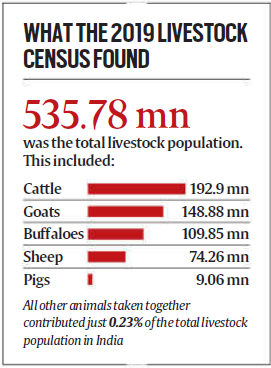
- The previous census recorded a total livestock population of 535.78 million in India, with cattle (192.9 million), goats (148.88 million), and buffaloes (109.85 million) comprising the majority.
- Smaller populations of other animals collectively contributed just 0.23% to the total.
- This data provides a benchmark for assessing trends in the current census.
5. Researchers Uncover Genetic Mechanisms in New Tardigrade Species That Enable Radiation Resistance, Paving the Way for Medical and Space Exploration Advances
(Source: Indian Express; Section: Explained; Page: 15)
| Context: |
|
Analysis of News:
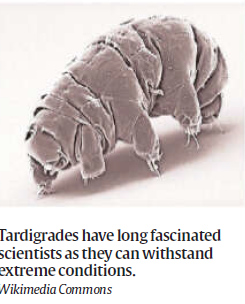
About Tardigrades:
- Tardigrades, often called water bears or moss piglets, are microscopic eight-legged animals.
- They are free-living tiny invertebrates belonging to the phylum Tardigrada.
- Around 1,300 species of tardigrades are found worldwide.
- Habitat:
- Considered aquatic because they require a thin layer of water around their bodies to prevent dehydration, they’ve also been observed in all kinds of environments, from the deep sea to sand dunes.
- Freshwater mosses and lichens are their preferred habitat, hence their nickname, moss piglet.
- They belong to an elite category of animals known as extremophiles, or critters that can survive extreme environments.
- They can survive punishing heat, freezing cold, ultraviolet radiation, and even outer space.
- Under unfavourable conditions, they go into a state of suspended animation called the “tun” state—in which the body dries out and appears as a lifeless ball (or tun).
- Tardigrades can survive as tuns for years, or even decades.
- Physical Features:
- Tardigrades are short, plump, and covered in a tough cuticle (similar to that of grasshoppers and other insects) that they must shed to grow.
- Tardigrades are mostly about 1 mm (0.04 inch) or less in size.
- Their tiny bodies contain no bones and are instead supported by a hydrostatic skeleton – a fluid-filled compartment known as a hemolymph.
- They have four pairs of legs, with 4-6 claws on each foot.
- Their specialised mouthpart–called a bucco pharyngeal apparatus–allows them to suck the nutrients out of plants and other microorganisms.
Study Details and Methodology
- The research, published in Science, involved genome sequencing, revealing 14,701 genes in Hypsibius henanensis, with 30% unique to tardigrades.
- The researchers exposed it to high doses of gamma rays, far exceeding levels survivable for humans, to study its radiation tolerance mechanisms.
Key Findings: Mechanisms of Radiation Resistance
The team identified three main mechanisms aiding radiation resistance:
- DNA Repair Protein (TRID1): Enables rapid repair of DNA double-strand breaks.
- Mitochondrial Synthesis Proteins: Activated during radiation exposure, these proteins also assist DNA repair.
- Antioxidant Pigments (Betalains): Produced by Hypsibius henanensis, these pigments neutralize harmful reactive chemicals formed during radiation exposure.
Potential Applications
- The study’s findings may benefit space travel, nuclear pollution cleanup, and cancer treatment.
- Tested on human cells, the tardigrade’s betalains significantly improved their survival rate under radiation, offering potential for future applications in human radiation protection.
6. Indians Lose Rs 120 Crore in ‘Digital Arrest’ Scams Linked to Southeast Asia, Reveals Government Data
(Source: Indian Express; Section: Cover Page; Page: 01)
| Context: |
|
Analysis of News:

Mechanisms of Digital Arrest Frauds
- In a typical “digital arrest” scam, criminals inform victims of alleged involvement in illegal activities.
- Often using video calls on platforms like Skype, these criminals pose as police officials and demand financial “settlements” to resolve the case.
- This manipulation extends to relatives and friends, pressuring victims to comply and keep them under constant watch until payment is received.

Regional Sources and Rising Complaints
- According to the Indian Cybercrime Coordination Centre (I4C), nearly half of cyber frauds (46%) reported from January to April 2024 originated in Myanmar, Laos, and Cambodia.
- With 7.4 lakh complaints in just four months, this surge follows a broader trend, as cybercrime complaints have consistently increased from 4.52 lakh in 2021 to over 15.56 lakh in 2023.
Broader Cybercrime Trends and Fraud Types
The I4C’s analysis highlights four prominent scam types:
- Digital Arrest Frauds: Rs 120.30 crore lost.
- Trading Scams: Rs 1,420.48 crore lost.
- Investment Scams: Rs 222.58 crore lost.
- Romance/Dating Scams: Rs 13.23 crore lost.
- With trading scams showing the highest financial impact, these fraud types reflect evolving strategies that criminals use to exploit victims financially and emotionally.
Southeast Asia as a Cybercrime Hub
- The I4C has identified Myanmar, Laos, and Cambodia as cybercrime hotspots, with operations targeting Indians through complex scams.
- Using fake employment opportunities on social media, criminals from these countries lure Indian victims into financial traps, leveraging technology and impersonation tactics to carry out frauds at a large scale.
- This situation underscores the need for coordinated international efforts to curb cross-border cybercrime and enhance India’s cybersecurity defenses.





